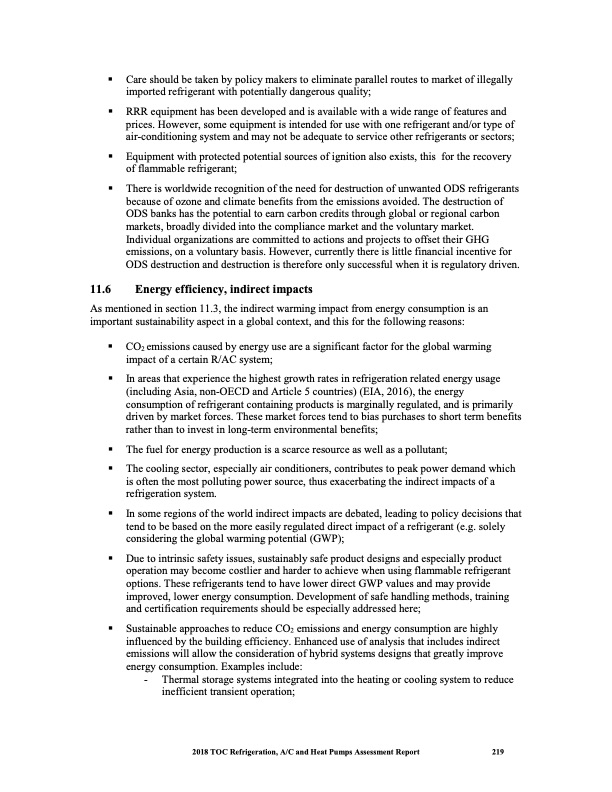
PDF Publication Title:
Text from PDF Page: 232
Care should be taken by policy makers to eliminate parallel routes to market of illegally imported refrigerant with potentially dangerous quality; RRR equipment has been developed and is available with a wide range of features and prices. However, some equipment is intended for use with one refrigerant and/or type of air-conditioning system and may not be adequate to service other refrigerants or sectors; Equipment with protected potential sources of ignition also exists, this for the recovery of flammable refrigerant; There is worldwide recognition of the need for destruction of unwanted ODS refrigerants because of ozone and climate benefits from the emissions avoided. The destruction of ODS banks has the potential to earn carbon credits through global or regional carbon markets, broadly divided into the compliance market and the voluntary market. Individual organizations are committed to actions and projects to offset their GHG emissions, on a voluntary basis. However, currently there is little financial incentive for ODS destruction and destruction is therefore only successful when it is regulatory driven. 11.6 Energy efficiency, indirect impacts As mentioned in section 11.3, the indirect warming impact from energy consumption is an important sustainability aspect in a global context, and this for the following reasons: CO2 emissions caused by energy use are a significant factor for the global warming impact of a certain R/AC system; In areas that experience the highest growth rates in refrigeration related energy usage (including Asia, non-OECD and Article 5 countries) (EIA, 2016), the energy consumption of refrigerant containing products is marginally regulated, and is primarily driven by market forces. These market forces tend to bias purchases to short term benefits rather than to invest in long-term environmental benefits; The fuel for energy production is a scarce resource as well as a pollutant; The cooling sector, especially air conditioners, contributes to peak power demand which is often the most polluting power source, thus exacerbating the indirect impacts of a refrigeration system. In some regions of the world indirect impacts are debated, leading to policy decisions that tend to be based on the more easily regulated direct impact of a refrigerant (e.g. solely considering the global warming potential (GWP); Due to intrinsic safety issues, sustainably safe product designs and especially product operation may become costlier and harder to achieve when using flammable refrigerant options. These refrigerants tend to have lower direct GWP values and may provide improved, lower energy consumption. Development of safe handling methods, training and certification requirements should be especially addressed here; Sustainable approaches to reduce CO2 emissions and energy consumption are highly influenced by the building efficiency. Enhanced use of analysis that includes indirect emissions will allow the consideration of hybrid systems designs that greatly improve energy consumption. Examples include: - Thermal storage systems integrated into the heating or cooling system to reduce inefficient transient operation; 2018 TOC Refrigeration, A/C and Heat Pumps Assessment Report 219PDF Image | Heat Pumps Technical Options

PDF Search Title:
Heat Pumps Technical OptionsOriginal File Name Searched:
RTOC-assessment-report-2018_0.pdfDIY PDF Search: Google It | Yahoo | Bing
CO2 Organic Rankine Cycle Experimenter Platform The supercritical CO2 phase change system is both a heat pump and organic rankine cycle which can be used for those purposes and as a supercritical extractor for advanced subcritical and supercritical extraction technology. Uses include producing nanoparticles, precious metal CO2 extraction, lithium battery recycling, and other applications... More Info
Heat Pumps CO2 ORC Heat Pump System Platform More Info
| CONTACT TEL: 608-238-6001 Email: greg@infinityturbine.com | RSS | AMP |